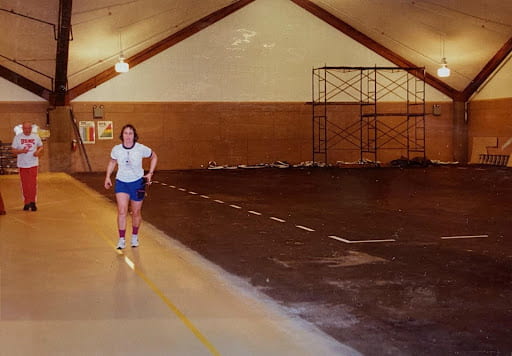
Dec 16, 2021 | Exclusive, Feature, News, Sports, TopStory |
By Michael Levesque, assistant editor and staff writer
This spring marks the 30th anniversary since the Fitness and Recreation Center (FRC) opened its doors to UMF and the community.
Since the building’s first official day on April 27, 1991, a lot has changed. Among these changes are the students and community members who use it, the staff who keep the building functioning, and the equipment inside. Noticeably missing from that list is the building itself. The Fitness and Recreation Center today greatly resembles the building that was made almost 30 years ago. “This office here used to have lockers where the group fitness instructors would change but it also had the director, the assistant director and the administrative assistant,” says Linda Blodgett as she gestures around the room her office is in. Blodgett has been working at the university since 1989. In 2001 she moved from the business office, where she started, to the FRC. “I was in the business office, it didn’t look like it does now,” said Blodgett. “Coming down here was much more comfortable for me – I haven’t regretted it. I have been on this campus for 32 years and I just love working down here.”
The familiar sight of the FRC has created an intimate atmosphere that many students and community members have come to value. “What I love the most is the sense of team camaraderie,” said Danny Terhune, a student and Physical Education instructor at the FRC. “[I love] the staff as a whole, you truly feel seen.”
“We’re such a unique facility, where the community comes in here and it’s really kind of neat,” Blodgett added. “Our staff that works here gets to know the community members and they see them outside of this place and our community members are always greeting them. It makes the students feel at home. It’s really really nice.”
Since the building’s erection in 1991, the building has adapted to the fitness and recreation needs of the community members. One year after the building was first opened to the public, the pool was installed. “Fitness is always evolving,” says Blodgett. “Body building was big back then. Group fitness was [also] really popular. Now it’s evolving into strength training.”
In order to meet the ever changing needs of the members of the community, constant work and refinement is done to the equipment within the FRC – with a cost as well. “There’s a lot of challenges,”says Blodgett, “the price of equipment is going up…[as well as] the maintenance of it. The cost of maintaining this equipment is a lot. There’s not a lot of companies around here that maintain equipment.” The COVID-19 pandemic has also contributed to the challenges at the FRC. “Trying to keep our membership up [is a challenge]. Our outside members, not just the students… are huge,” Blodgett says.
Even as the challenges continue, many in the community still treasure the building and the community with it. “I hope this place stays here forever,” says Blodgett. “I just hope that UMF… realizes how much this facility means to the people – students and community members… I hope it stays for the next 30 years because it is a great facility and it’s great for our students… You know, our students that work here learn so much about dealing with the public, it gets their confidence up. A lot of our graduates that work here say they haven’t found a facility they like more than here.”
“I love how I get to share my love of fitness with these coworkers as well as students in my class,” Terhune says. “This helps me as an education major really practice my skills as a teacher outside of my normal classes.”
Ben White, Director of Fitness and Recreation at the FRC, was pleased to announce some of the celebrations for the 30th anniversary coming in the spring. “A canoe race, mountain bike race, and 5k run” are all scheduled for the spring, according to White. As of right now these activities are scheduled for April 30th, 2022 – three days after the official 30th anniversary day. A reception will also be held later than afternoon. “The hope is that we get as many alumni back that we can that have worked here or that have gone to school here. I know a lot of alumni that went to school here that have never stepped foot in the building,” Blodgett says.
More details about the celebration in April are expected to be released on the FRC Instagram and Facebook pages as well as through their newsletter. The front desk at the FRC can be contacted at (207)-778-7495.
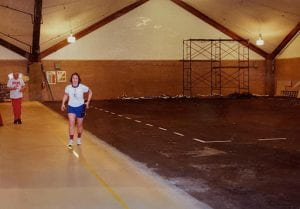
Community members inside the FRC prior to the completion of a basketball court. Photo courtesy of Linda Blodgett.
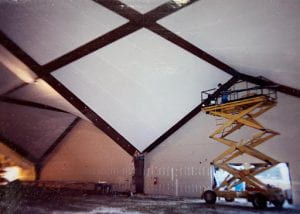
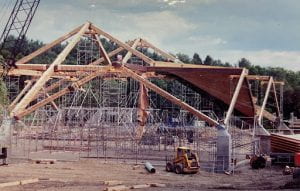
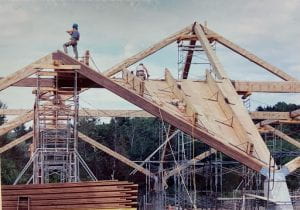
Construction on the Fitness and Recreation Center building. Photo courtesy of Linda Blodgett.
Dec 16, 2021 | Exclusive, Feature, News |
By Michael Levesque, Contributing Writer
Recent construction on High Street addresses an important area of campus but some students feel a little unsure about how to navigate the project.
At the end of October, construction began on a section of High Street from Perham Street to South Street. This area of road runs directly through the center of campus at UMF. For some students, the construction has created a bit of surprises as they make the trip to their classes. Paige Lusczyk, a student at UMF notes some confusion about where students were permitted to walk. “I wasn’t sure if I’d get in trouble with crossing the road while they were working and was late to class by walking around the blocked off road,” she said in an email. “I don’t really hear much of the construction, even with my windows always open,” she said. Although Lusczyk doesn’t note the sound as contributing to the construction drawbacks, other students have. Zack Laflamme, a junior at UMF, says that Francis Allen Black Hall has been affected less by noise from construction but has heard about complaints from the noise through social media. “I live in FAB, so I don’t hear it much but I’ve seen my friends say on their Snapchat stories how loud or distracting the noise is,” Laflamme said. Most students note that noise hasn’t been a terrible issue and that they will get used to the new scene on campus. “I haven’t found the construction all that frustrating,” said Lusczyk.
High Street’s location to UMF means careful planning must be implemented for the members of the community. Philip Hutchins, the public works department head for Farmington, has noted the goals and plans of this project. “The High Street project will last until 2022,” he said in an email. “This is split up in two phases. The roadway pave portion will be completed this fall; which will soon be open to traffic again,” said Hutchins. “[In] the spring of 2022, we will commence on the outside of roadway construction.” Many assets are expected to be added to the area around UMF in the spring. “An addition of over 30 new street lamps, new sidewalks, curbing and more parking accessibility, such as bus turn-outs for campus activities [will be added],” said Hutchins.
Hutchins understands the possible confusion and magnitude of the project. “I ask for everyone’s patience until the project is completed,” he said. As part of a “full depth reconstruction” project listed on the public works department website, the expected cost of this project is $300,000.“This project is funded by local municipal government and by the Maine Department of Transportation,” Hutchins added. As many people look forward to a potentially more quiet section of road, others look towards the improvements in the future. “This project will give the area a whole new welcoming and warming look”
Oct 11, 2021 | Exclusive, Feature, Sports, TopStory |
By Michael Levesque, Assistant Editor.
On Saturday September 25, 2021, the men’s and women’s cross country teams traveled to Saxl Park in Bangor, Maine to compete at the Husson Harrier Invitational.
A good race day for the men’s and women’s team was highlighted with the men’s squad capturing first place. Five members from the men’s team finished within the top 32 positions with three runners finishing in the top 15.
Captain Joe Ashby, a senior, finished 21st overall and indicated some uncertainty before the race in regards to where they would finish. “Going into the meet we weren’t really sure if we would win because we know that Colby [College] and Husson [University] have really strong programs,” Ashby said. “But we were there to run hard and compete.” Improving on their times was the main focus of practice in the weeks leading up to the meet but actually winning the meet became the overall goal. “We are training really hard for times but at the end of the day, we are here to win the NAC [North Atlantic Conference],” Ashby said.
Coach Sean Cabaniss said through the teams Instagram page that the men’s win was the “first time since 2018.” Cabaniss also said on the page that many of the team members individually had great races with “PR’s[personal records] almost across the board.”Ashby also recognized the efforts of each runner. “We have a really strong team this year. With NAC’s being at a difficult course this year, [Saturday October 30th hosted by Thomas College] we really want to win.”
Ashby knows that even with the recent success, challenges still remain ahead. “Winning is never easy. We weren’t the smallest team there but I do think we were the second smallest.” One major challenge to winning each race is the team size. “It’s hard when you have a bunch of other runners to displace your guys,” Ashby said.
But with any success comes a sense of pride. Ashby recognizes the overall accomplishment of the team. “To win was a great feeling because I don’t think we have won a meet in quite a few years.”
The Cross Country teams will have their next two meets Saturday October 2nd [hosted by Bates] and Saturday October 23 [hosted by Bowdoin] before competing in the NAC championship on October 30th.
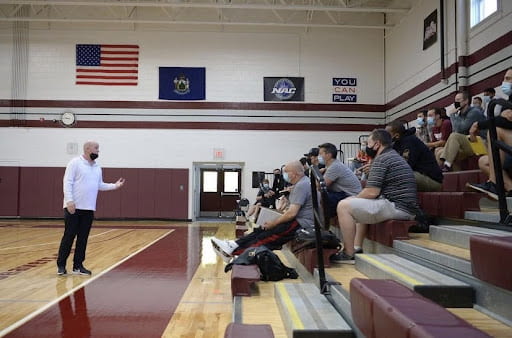
Sep 27, 2021 | Feature, News, Sports, TopStory |
By Michael Levesque, Assistant Editor.
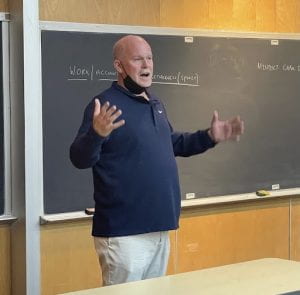
Photo from the UMF Athletic Department
On September 10, 2021, student-athletes and members within the University of Maine Farmington athletics department had the opportunity to listen to alumumnist and National Basketball Association coach, Steve Clifford.
Clifford returned to the college from which he graduated in 1983 to talk about his experience coaching basketball at the highest level. Clifford, who graduated from the university in 1983 with a bachelor’s degree in special education, played basketball for UMF all four years. After graduation, he coached at the high school and college level before accepting a position as an assistant coach for the New York Knicks in 2001. Clifford was an assistant coach in the league for 12 more years before becoming the head coach for the Charlotte Hornets in 2013 and later the Orlando Magic. Today Clifford is a coaching consultant for the Brooklyn Nets.
Clifford first talked to a large group of UMF student athletes, where he touched on values that he believes are not only good for NBA players, but athletes in general. “Work, accountability and togetherness… These are the three main ideas that he focuses on with the NBA teams that he has coached,” said McKenna Brodeur in an email. Brodeur is a captain on the women’s soccer team and a post player on the women’s basketball team. “All three ideas…impact a team’s culture,” she said. “Work requires you to put the effort in. Accountability means having discipline and showing up every day on time, as well as knowing the plays and sets. Lastly, togetherness is the goal of the team,” she said. “You need to be able to play together and have a plan to get better.” Brodeur mentioned that some of the messages she learned, she plans on taking to the soccer field. “I want to bring back what I learned from Coach Clifford back to the team. I think it will be a good reminder on why we cannot just show up to practice and expect greatness. We must work toward our goals and aim to do better every day,” Brodeur said.
Clifford’s visit then transitioned to the basketball court where he conducted a coaching clinic. With UMF men’s basketball players on the court and coaches from around the state in the bleachers, Clifford conducted a few drills and offered coaches advice on running a successful basketball team. “[Clifford] showed us different drills and plays and how they transitioned to success at the NBA level,” said Jack Kane, a center on the men’s basketball team. Kane mentioned how other coaches were there to learn as much from Clifford as they possibly could, including UMF’s own coach Sam Leal. “Coach was taking notes in the stands, listening. He was not ‘coaching’ at all,” said Kane. Kane, like the other members of the team actually completing the drills that day, hopes that what they learned from Clifford can translate to a successful season this winter.
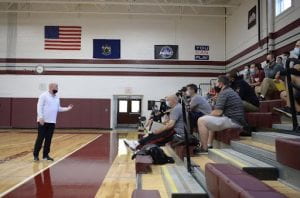
For more photos of Clifford’s visit, check out the athletic department’s instagram page @umfatheltics.

Mar 6, 2021 | Archives, Feature |
By Michael Levesque, Contributing Writer

Photo courtesy of Nancy Prentiss, Biology Class
The Natural History of a Maine Watershed class taught by Nancy Prentiss, accompanied by Maine aquatic professionals, ventured out to lay Atlantic salmon eggs near Avon, ME.
Classified as an endangered species, Atlantic Salmon are almost exclusively found in New England and waters north. These fish travel up rivers, like the Sandy, to lay their eggs and exit later to spend years of their lives out in the Atlantic Ocean. After their time in the ocean, they return to roughly the same area where they hatched from their eggs to lay eggs of their own and repeat the process.
Nancy Prentiss, the professor of the Natural History of a Maine Watershed class, has now made this trip three years in a row. She looks forward to this trip every year. “I’m definitely a field person,” Prentiss says, “I really pushed hard to submit a form for approval.” Luckily for the class, approval was given. They were able to utilize the class’ small number of students and independent travel to help make sure that everyone involved stayed safe.
Joining Prentiss and eight members of the class were the Department of Marine Resources, the Atlantic Salmon Federation and the National Marine Fisheries Service. Previously, the class prepared for the trip by practicing using snowshoes the week before. Despite frigid weather, COVID-19, and having to trudge through snow on snowshoes, the class persevered.
After locating a spot to lay the eggs, a gravel nest was made–similar to that made by actual salmon–to help protect the eggs. A tool resembling a funnel was used to create the depression in the ground. This process was delayed as cold temperatures made some of their equipment freeze. Although there were delays, Prentiss and her class embraced the challenges. “This is science,” Prentiss said.
Describing the eggs as similar to “Orbeez”, Hope Norton mentions she wasn’t expecting a class trip like this involving professionals to happen. The eggs were previously fertilized three months before. As eggs and young fish, they will call that nest home for approximately two years before making their own journey to the ocean. “I just love throwing students into a situation and then you learn by doing,” Prentiss says. “When [the students] are doing it themselves, that’s the best way to learn.”
Lauren Preis, a student in the class, described the struggles these salmon face today. “They have trouble migrating because of dams and culverts,” said Preis. “For every 15,000 eggs, only one adult salmon fish will return,” Preis says. Because of these grim statistics, blockages are a problem for the Sandy River and for other places and species as well.
Although these rates are alarming and frustrating, some studies and efforts show these fish as possibly having a chance. “There are fish returning from the fertilized eggs they have planted,” Prentiss says. Efforts made by educational institutions like colleges and high schools in Maine as well as state and federal agencies have produced some hopeful results.
For the class, this was an experience that shaped their student experience while getting them outside of UMF. “It was an amazing life experience,” Preis said.
Preis and her classmates perhaps didn’t imagine taking such a trip in the beginning of the semester, but are grateful nonetheless. “I wish I could do it with everybody,” Prentiss said. “We are always in a different stream and every time I go, I learn more.”
Prentiss is hopeful her class will be able to continue this tradition and have more people down the road lay salmon eggs. The shared goal of this class and others in the industry is to remove these fish from the endangered species list.








